The Setting Sun - Gotterdammerung, Japan 1944.
- Thread starter unmerged(59906)
- Start date
-
We have updated our Community Code of Conduct. Please read through the new rules for the forum that are an integral part of Paradox Interactive’s User Agreement.
You are using an out of date browser. It may not display this or other websites correctly.
You should upgrade or use an alternative browser.
You should upgrade or use an alternative browser.
sbr said:I hope you have something to do to pass the time, even Remble won't be able to do that anytime soon. Unless he gets the Super Secret Sheep bomb. :rofl:
I have full confidence in his abilities
Kyronea said:Why is East Timor still under the control of the Portuguese?
east temor has always been under the control of the portuguese, Japan never invadered Portuguese held territories. Well not offically!
Originally posted by Reado:
east temor has always been under the control of the portuguese, Japan never invadered Portuguese held territories. Well not offically!
When Japan was in full swing with their Southern Campaign, the Dutch and Australians seized East Timor. The Dutch withdrew, but the Australians waged a commando war against the Japanese invaders, with the support of the native population. The Japanese had trouble cleaning them out, sending many troops there. In the end, the Allied force retreated across sea, but they had succeeded in tieing up a whole division, preventing them from being used further east. So East Timor had already been invaded once when the Japanese got there! For a few years, Portugal lost a colony without being involved in the war.
If the A.I. on Very Hard is anything like the A.I. on the easier difficulties, they won't. Really, Paradox needs to follow other game companies' examples(like, say, Stardock) and completely rework the A.I. system.sbr said:Looking good so far. Knock on wood.
I wonder how long until the US starts escorting their transports.
Reado, Mangudai: Ah, I see. Thank you.
Lots of action going on while I was gone.
Also, I don't think the Chinese even needed a reply, their offer was so pathetic.
Also, I don't think the Chinese even needed a reply, their offer was so pathetic.
konnichi wa 
"a creek without paddle" was great stuff.
When I saw the master of the last stand returned to show a new AAR, I decided to join here.
Written very well, again.
"a creek without paddle" was great stuff.
When I saw the master of the last stand returned to show a new AAR, I decided to join here.
Written very well, again.
I'm surprised to see how well the war is going until now. The only serious loss you've had was a destroyer flotilla. Though actually I'm more worried about your depleting airforce, since Japanese IC is the rarest good of them all.
Very well done so far, subscribed!
Looking forward to seeing how you save the rising sun.
Looking forward to seeing how you save the rising sun.
Admiral Yamamot, sbr, stnylan, Winner - Thank you all 
Kyronea, Reado, Mangudai - Thank you for pointing out the status of East Timor so precisely
sbr, Kyronea - One of the AI's more obvious flaws although it does actually try to escort one in the next update. It might well get a little more serious about it soon.
Maj. von Mauser - A white peace was a little pathetic but they haven't actually lost, or gained, anything so it was probably logical. They aren't Allied to the Nationalists either which is very likely going to hurt the Nationalists a lot in the near future.
Hermann Steiner - Thank you and welcome to the AAR and to the boards
Sokraates - Using airforce correctly drastically reduces naval combat losses. Firstly I know where the enemy is and can avoid bad battles and secondly I can bomb their capital ships to death. I avoided this is my previous AAR as it is a little gamey to do it. That AAR was on normal though, this isn't, so I get to use my aircraft to actually protect my fragile fleet.
My depleting airforce is also one of my main concerns, after energy. The reason my aircraft are suffering what appears to be so much damage is twofold. Firstly bombing aircraft carriers hurts a little, especially when they are adequately escorted.
Secondly it is a function of timezone. Unfortunately all repairs are always carried out at 0000 hours and dawn is roughly 2200 hours in Asia and a lot of the Pacific. This means that none of my aircraft are repaired at 0000 hours unless they are not on a mission as they are already airborne. One really major disadvantage of playing any Country in this region.
String Theory - Thank you and welcome to both the boards and this AAR
Update to follow to conclude July ...
Kyronea, Reado, Mangudai - Thank you for pointing out the status of East Timor so precisely
sbr, Kyronea - One of the AI's more obvious flaws although it does actually try to escort one in the next update. It might well get a little more serious about it soon.
Maj. von Mauser - A white peace was a little pathetic but they haven't actually lost, or gained, anything so it was probably logical. They aren't Allied to the Nationalists either which is very likely going to hurt the Nationalists a lot in the near future.
Hermann Steiner - Thank you and welcome to the AAR and to the boards
Sokraates - Using airforce correctly drastically reduces naval combat losses. Firstly I know where the enemy is and can avoid bad battles and secondly I can bomb their capital ships to death. I avoided this is my previous AAR as it is a little gamey to do it. That AAR was on normal though, this isn't, so I get to use my aircraft to actually protect my fragile fleet.
My depleting airforce is also one of my main concerns, after energy. The reason my aircraft are suffering what appears to be so much damage is twofold. Firstly bombing aircraft carriers hurts a little, especially when they are adequately escorted.
Secondly it is a function of timezone. Unfortunately all repairs are always carried out at 0000 hours and dawn is roughly 2200 hours in Asia and a lot of the Pacific. This means that none of my aircraft are repaired at 0000 hours unless they are not on a mission as they are already airborne. One really major disadvantage of playing any Country in this region.
String Theory - Thank you and welcome to both the boards and this AAR
Update to follow to conclude July ...
Stemming the Tide
8
1200 July 22nd 1944.
North China Army Headquarters. Hengyang, China.
The British had made a second advance into Japanese territory in Burma. Higashikuni could do little about it until some of his forces became free from their current obligations.
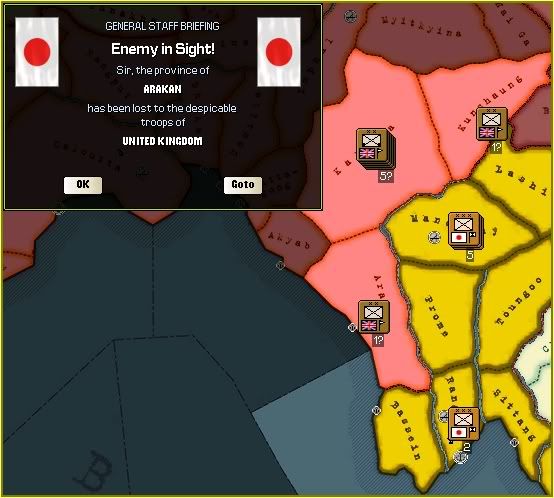
The coastal province of Arakan would allow further advances for British troops including towards the unprotected Prome. Rangoon and Mandalay were more important to defend for now and these forces would remain in place until forced to do otherwise.
0000 July 23rd 1944.
Industry Offices. Tokyo Japan.
Fujiwara Ginjiro had exercised some initiative to increase the speed at which the population's dissent declined. He had halted the production of supplies and utilised this production for more consumer goods.
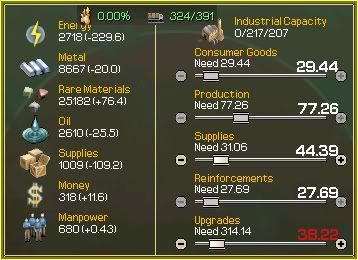
The result was the total reduction of dissent almost a week ahead of schedule. The supply stockpile would need to be rebuilt but Ginjiro had one less thing to worry about.
Excess industrial output was made available for troop reinforcements and upgrades to bring Japan's armed forces up to par.
Excess industrial output was made available for troop reinforcements and upgrades to bring Japan's armed forces up to par.
0100 July 23rd 1944.
North China Army Headquarters. Hengyang, China.
The arrival of General Nishio and his cavalry in Kaili had allowed for more offensive manouvers to commence in southern China. Higashikuni had also decided that it was time to begin reducing the Chinese pocket in the south east.
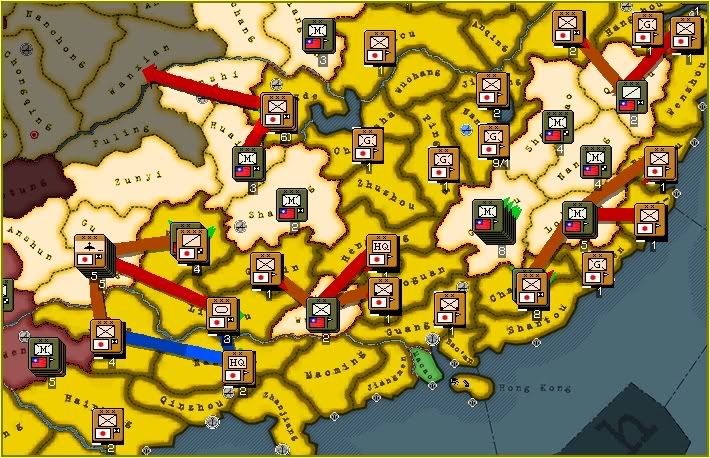
Attacks began all across the south of China as Japanese forces responded to their most recent orders from North China Army Headquarters.
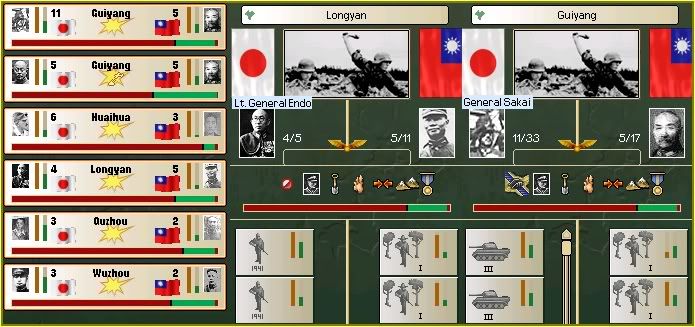
Only two of the attacks gave Higashikuni any cause for concern and even these were not thought to be any real trouble.
Lt. General Endo, attacking Longyan, met with some resistance initially but the Chinese troops facing him had little stomach left for a fight after being deprived of supplies for several weeks. A similar attack against Quzhou, led by Lt. General Funabiki, would also be a short battle.
General Itagaki would overpower the defenders of Huaihua within two hours as he advanced towards the province in order to isolate enemy forces in Shaoyang.
Only two battles would last through the night including the main battle for Guiyang province.
Lt. General Endo, attacking Longyan, met with some resistance initially but the Chinese troops facing him had little stomach left for a fight after being deprived of supplies for several weeks. A similar attack against Quzhou, led by Lt. General Funabiki, would also be a short battle.
General Itagaki would overpower the defenders of Huaihua within two hours as he advanced towards the province in order to isolate enemy forces in Shaoyang.
Only two battles would last through the night including the main battle for Guiyang province.
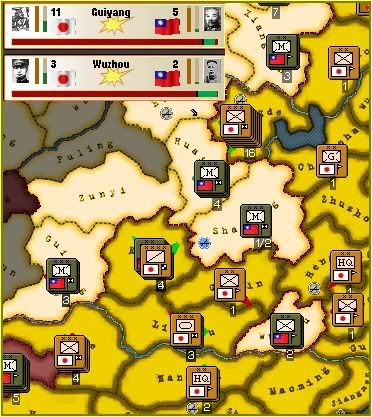
By 2100 hours both remaining battles were almost over with Higashikuni's own fight for Wuzhou largely being decided by the enemy troops isolation.
General Sakai would overpower his opponent as the sun rose. Nakajima's Close Air Support aircraft forced the battle in his favour. Progress was beginning to increase in pace as the days wore on and Higashikuni was satisfied with the current state of affairs in China.
General Sakai would overpower his opponent as the sun rose. Nakajima's Close Air Support aircraft forced the battle in his favour. Progress was beginning to increase in pace as the days wore on and Higashikuni was satisfied with the current state of affairs in China.
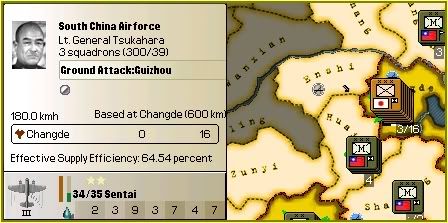
The news that Lt. General Tsukahara's Tactical bomber wing was also available after repairs added to his satisfaction as he ordered them to begin bombing enemy troops south west of Changde. Several more days would be required before he would have all nine squadrons available but at least this was a start.
1900 July 24th 1944.
BB Division 1 Flagship. IJN Yamashiro, Saipan.
Yamamoto had reached Saipan without incident and he had already given the required orders to begin the repair of his damaged ships. Nomura had also finished delivering troops to various islands in Indonesia.
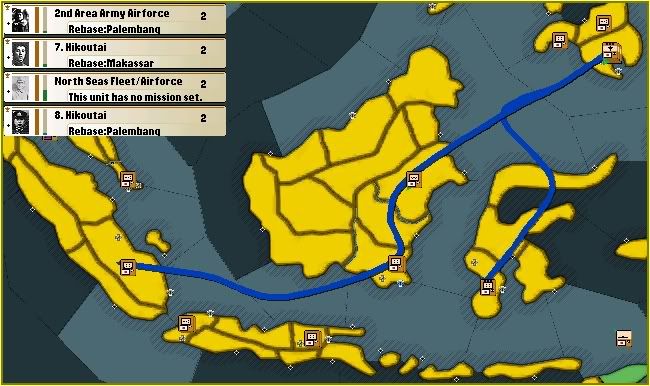
Several small two squadron interceptor wings began their flights to various bases around the islands of Indonesia. Once rested they would be conducting Naval combat patrols to monitor enemy shipping movements in the area and provide advance warning of any possible threats.
0000 July 25th 1944.
Diplomatic Offices. Tokyo, Japan.
Mamoru still needed to find more energy to help keep Japan's industry running at full capacity. As always he had few options for trade in this commodity.

Agreements with Sweden and Argentina were struck that saw Japan's energy reserves increase by just under 1400 tons. An extra six to seven days worth industrial production.
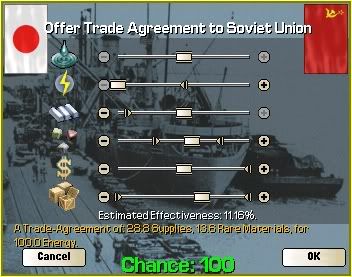
He did not stop there. He also managed to broker a deal with the Soviet Union for a large quantity of energy to be delivered daily in exchange for Japanese surplus. A pity that only around 10% of the energy would arrive. Maybe in time this trade would see greater benefit, but for now it at least made relations with Japan's northern neighbour slightly more cordial.
0600 July 25th 1944.
BB Division 1 Flagship. IJN Yamashiro, Saipan.
Rear Admiral Suekuni had encountered another enemy Transport fleet during the course of his patrol off the coast of Saipan.
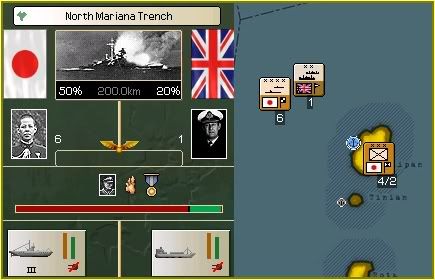
BB Division 1 would ignore the threat as the British fleet would be long gone before it could leave harbour. Suekuni would force the fleet away from its target after chasing it for four hours.
Are the Chinese completely cut-off from outside aide?
Plus, I find it to be really confusing. It's like, "We can repair your aircraft at midnight, but dawn is nearby."
It's like, "We can repair your aircraft at midnight, but dawn is nearby."
Remble said:Secondly it is a function of timezone. Unfortunately all repairs are always carried out at 0000 hours and dawn is roughly 2200 hours in Asia and a lot of the Pacific. This means that none of my aircraft are repaired at 0000 hours unless they are not on a mission as they are already airborne. One really major disadvantage of playing any Country in this region.
Plus, I find it to be really confusing.
1000 July 26th 1944.
North China Army Headquarters. Hengyang, China.
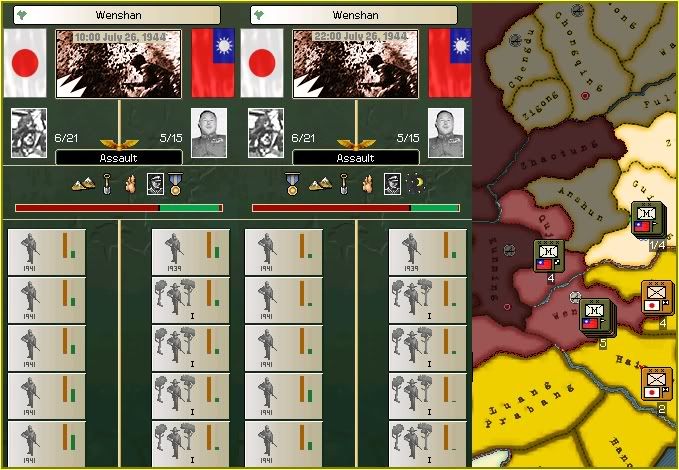
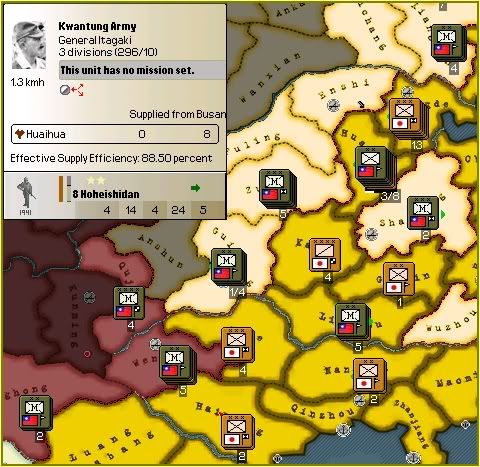
0100 July 27th 1944.
The Skies Above South Ryukyu.
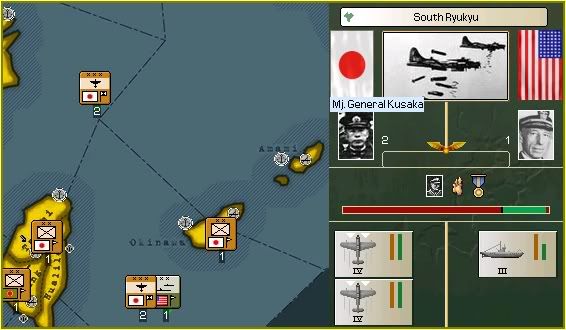
0300 July 27th 1944.
North China Army Headquarters. Hengyang, China.
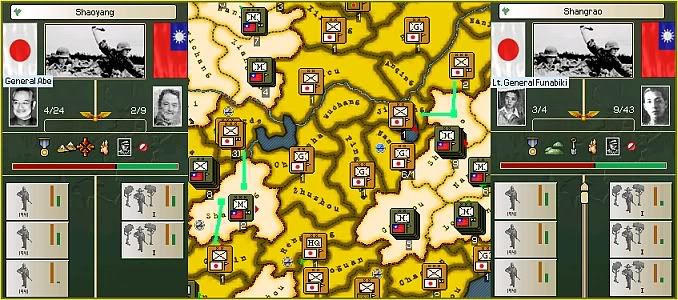
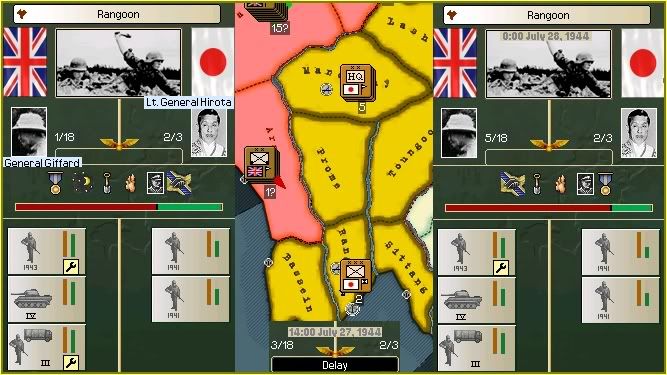
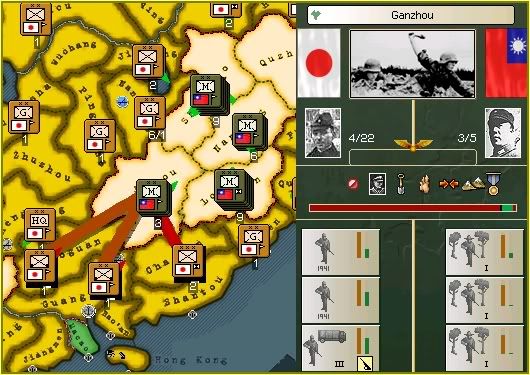
2200 July 28th 1944.
BB Division 1 Flagship. IJN Yamashiro, Saipan.
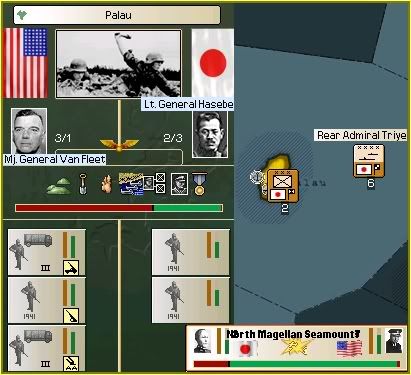
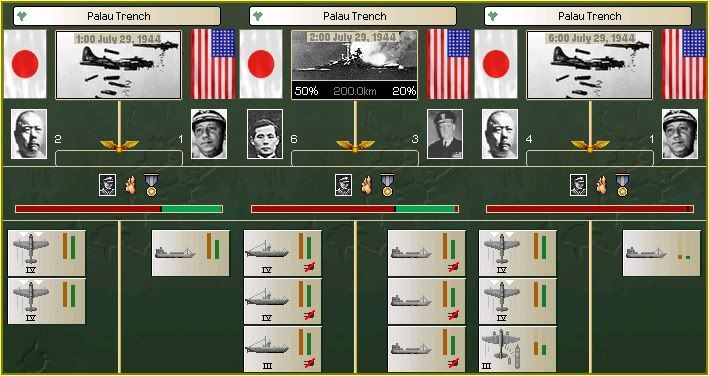
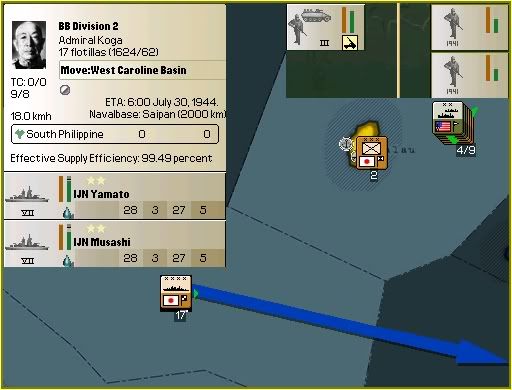

North China Army Headquarters. Hengyang, China.
It was time to place some more pressure on the creaking Chinese line in the south. The Yunnanese would bare the brunt of this new attack.

General Sakai led six divisions into the mountains of Wenshan to do battle with five divisions, mostly militia, defending the province.
By the time dawn approached the defences were already crumbling and the arrival of dive bombers would bring the battle to a swift conclusion in Sakai's favour.
By the time dawn approached the defences were already crumbling and the arrival of dive bombers would bring the battle to a swift conclusion in Sakai's favour.

General Itagaki arrived in Huaihua at 2200 hours to complete the encirclement of two Chinese divisions in Shaoyang. These enemy troops were attempting to march east but they would not get very far.
0100 July 27th 1944.
The Skies Above South Ryukyu.
Mj. General Kusaka, whose aircraft were based in Okinawa, was currently patrolling the sealanes between Taiwan and Japan. He was not expecting to find any hostile shipping in this region.

He encountered an American Submarine Division attempting to harass Japanese convoys. Supplies from outlying regions were vital to Japan's survival and this sort of enemy action would not be tolerated. Kusaka would not be able to inflict much damage upon the Submarines but he could prevent them from conducting their mission effectively.
0300 July 27th 1944.
North China Army Headquarters. Hengyang, China.
The two divisions in Shaoyang needed to be captured before they could get themselves into any mischief. Higashikuni had enough troops available to force the issue and he used them.

General Abe, in Changde, led the attack against these isolated forces in support of the actual advance from the south. Two more enemy divisions would fight no more.
Lt. General Funabiki led a second assault against the shrinking pocket in south eastern China. Shangrao province was his target and he would easily defeat the now almost starving nine defending divisions.
Lt. General Funabiki led a second assault against the shrinking pocket in south eastern China. Shangrao province was his target and he would easily defeat the now almost starving nine defending divisions.

The British were beginning to get pushy in Burma and had attacked Lt. General Hirota's position in Rangoon. This province was fairly vital as it contained both a port and airbase that Higashikuni would rather not let the Allies have.
Hirota fought bravely to defend the province, even delaying the forces attacking him, but the addition of two extra divisions in the early morning left him no choice but to withdraw to Sittang.
Japanese forces in Mandalay were also ordered to withdraw to Toungoo as their position had now become intenable.
Hirota fought bravely to defend the province, even delaying the forces attacking him, but the addition of two extra divisions in the early morning left him no choice but to withdraw to Sittang.
Japanese forces in Mandalay were also ordered to withdraw to Toungoo as their position had now become intenable.

The initial attacks against the south eastern pocket had gone well and Higashikuni ordered another attack to reduce it still further.
Ganzhou province was the latest target of Japanese aggression with General Asaka leading the successfull assault. With enemy forces retreating from Ganzhou some Japanese troops would now become available for deployment elsewhere.
The two motorised divisions, including that of General Asaka, would shortly redeploy to Burma to assist with the defence of that region.
Ganzhou province was the latest target of Japanese aggression with General Asaka leading the successfull assault. With enemy forces retreating from Ganzhou some Japanese troops would now become available for deployment elsewhere.
The two motorised divisions, including that of General Asaka, would shortly redeploy to Burma to assist with the defence of that region.
2200 July 28th 1944.
BB Division 1 Flagship. IJN Yamashiro, Saipan.
The report Yamamoto had in his hand was clear. He had taken great pains to avoid this type of enemy action and he would need to speak to a certain Submarine commander in the very near future.
The report was from Lt. General Hasebe, the commander of defensive forces on the island of Palau. It simply read:
The report was from Lt. General Hasebe, the commander of defensive forces on the island of Palau. It simply read:
To: BB Division 1
Attention: Commander Japanese Forces in the Pacific.
At 2200 hours on July 28th 1944 three enemy divisions began an amphibious assault against Japanese forces defending Palau. Request immediate assistance.
Lt. General Hasabe.
Commander Palau Garrison.
Palau.
Attention: Commander Japanese Forces in the Pacific.
At 2200 hours on July 28th 1944 three enemy divisions began an amphibious assault against Japanese forces defending Palau. Request immediate assistance.
Lt. General Hasabe.
Commander Palau Garrison.
Palau.

Yamamoto had no idea how three fully laden Transport fleets had by-passed Rear Admiral Triye's Submarines but he would find out in due course. In the mean time he would be required to salvage the situation.
Air General Ozawa was busy bombing a medium sized American Cruiser fleet to the north east. His report indicated that this fleet was also heading towards Palau. The resting air wings were scrambled to go and hunt whatever fleet was responsible for invading Palau. There was no report at all to go on that indicated numbers of enemy vessels in the region, only a report clearly stating that three enemy divisions were there.
Air General Ozawa was busy bombing a medium sized American Cruiser fleet to the north east. His report indicated that this fleet was also heading towards Palau. The resting air wings were scrambled to go and hunt whatever fleet was responsible for invading Palau. There was no report at all to go on that indicated numbers of enemy vessels in the region, only a report clearly stating that three enemy divisions were there.

The first commander to find anything in the Palau Trench was Air General Yamshita. He encountered one Transport fleet which he began to strafe with his interceptors. Three hours had already passed with casualties mounting on Palau.
It wasn't until 0300 hours that Yamamoto finally received an accurate report of enemy shipping in the Palau Trench. Triye had encountered only three unescorted Transport fleets. Clearly the escorting fleet was actually late although it was definately on its way, still being harassed by Ozawa's Naval bombers. They had already sunk one Heavy Cruiser, the USS Chester.
The addition of two Naval bombers from Mj. General Genda's wing had made a noticable impact on one Transport fleet at least.
At 0700 hours, with their escort still not arrived, the Transport ships had little choice but to withdraw as Japanese Submarines hunted them. None had been sunk but a large amount of casualties had been inflicted upon thier cargo during the nine hours of beach assault.
Yamamoto was fairly confident that Hasebe and his men would have held the island without any intervention, but his forces where arrayed as they were to prevent such a need for bloodshed.
It wasn't until 0300 hours that Yamamoto finally received an accurate report of enemy shipping in the Palau Trench. Triye had encountered only three unescorted Transport fleets. Clearly the escorting fleet was actually late although it was definately on its way, still being harassed by Ozawa's Naval bombers. They had already sunk one Heavy Cruiser, the USS Chester.
The addition of two Naval bombers from Mj. General Genda's wing had made a noticable impact on one Transport fleet at least.
At 0700 hours, with their escort still not arrived, the Transport ships had little choice but to withdraw as Japanese Submarines hunted them. None had been sunk but a large amount of casualties had been inflicted upon thier cargo during the nine hours of beach assault.
Yamamoto was fairly confident that Hasebe and his men would have held the island without any intervention, but his forces where arrayed as they were to prevent such a need for bloodshed.

The next piece of news he received was even more disturbing as a second invasion had begun against Palau, this one also going undetected, despite the high alert status of his forces.
The single mechanised division had no chance of success but it could well have swung the battle had the initial three divisions still been in combat.
Admiral Koga, who had been heading to Palau after escorting Nomura's Transport fleet safely to Sorong, was ordered to alter course and head south east to intercept the fleeing Transport fleets.
The single mechanised division had no chance of success but it could well have swung the battle had the initial three divisions still been in combat.
Admiral Koga, who had been heading to Palau after escorting Nomura's Transport fleet safely to Sorong, was ordered to alter course and head south east to intercept the fleeing Transport fleets.

BB Division 2 had no problems sighting bulky and heavily laden Transport ships and sent all three fleets to the bottom of the Pacific, along with what remained of two motorised and one infantry division.
The Battleship IJN Nagato would sink one and the IJN Yamato the other two.
Koga turned his fleet north to try and intercept the Cruiser fleet that had finally arrived off Palau.
The Battleship IJN Nagato would sink one and the IJN Yamato the other two.
Koga turned his fleet north to try and intercept the Cruiser fleet that had finally arrived off Palau.
Wait, why didn't you counterattack from Mandelay when Rangoon was under attack? You had five divisions, and with seven overall you ought to have been able to push them off. I remember you using this to great effect during "Creek Without a Paddle."
Burma remains a place to trade space for time. And given your progress in China if you can just somehow delay the British advance you might very well end up being able to flank the British position there.
Are you going to annex hole China or will you split it up by the warlord States?
btw: what´s happening in europe, especially germany?
btw: what´s happening in europe, especially germany?
Inner Circle said:btw: what´s happening in europe, especially germany?
Götterdammerung, I guess
You always learn something new. Thanks for the information on repairs.
Nice going in China, though after checking the VP-provinces it should still take some time for you to annex them. ... unless they annex some western neighbor first, which would prolong the war even more.
Regarding the mysterious invasion attempts against Palau: aren't the Dutch part of the Allies? This would explain those ghostly ships.
Nice going in China, though after checking the VP-provinces it should still take some time for you to annex them. ... unless they annex some western neighbor first, which would prolong the war even more.
Regarding the mysterious invasion attempts against Palau: aren't the Dutch part of the Allies? This would explain those ghostly ships.
China is going well, Burma is gaining time and the Pacific is confusing as always... I guess everything's fine... 

